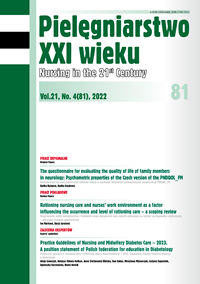Pain and functioning of patients after endovascular treatment of thoracoabdominal aortic aneurysms during the first five days after the procedure
DOI:
https://doi.org/10.2478/pielxxiw-2022-0036Keywords:
pain, endovascular aneurysm repair, thoracoabdominal aortic aneurysm, functioning of patientsAbstract
PAIN AND FUNCTIONING OF PATIENTS AFTER ENDOVASCULAR TREATMENT OF THORACOABDOMINAL AORTIC ANEURYSMS DURING THE FIRST FIVE DAYS AFTER THE PROCEDURE
Aim. The study assessed the pain and functioning of patients after thoracoabdominal aortic aneurysms surgery.
Material and methods. The study involved 35 patients after the thoracoabdominal aortic aneurysm surgery. The study used the method of a diagnostic survey, and the research tool was a proprietary questionnaire, using a numerical and descriptive pain scale and the Laitinen Scale. The results were analyzed in the program SPSS Statistics 21.0.
Results. When it comes to 54.3% of the respondents, they experienced the strongest pain on the fi rst day after the procedure, 45.7% experienced the pain periodically and it was felt the most in the evening (48%). More than half of the respondents indicated that the experienced pain completely aff ected the movement/walking and it was the strongest then, and it was the same while getting up. Pain intensity and the presence of functional limitations did not have a statistically signifi cant correlation with the analyzed socio-medical variables (p>0.05).
Conclusions. Patients experienced the pain after thoracoabdominal aortic aneurysm surgery and it limited their functioning, therefore they needed help in performing basic life activities.
References
1. Buck DB, van Herwaarden J, Schermerhorn ML, et al. Endovascular treatment of abdominal aortic aneurysms. Nat Rev Cardiol. 2014; 11(2):112-23. doi: 10.1038/ nrcardio.2013.196.
2. Mathiesen O, Thomsen BA, Kitter B, et al. Need for improved treatment of postoperative pain. DMJ. 2012; 59(4): 1-4.
3. Buvanendran A, Fiala J, Patel KA, et al. The incidence and severity of postoperative pain following inpatient surgery. Pain Medicine. 2015; 16(12): 2277-2283. https:// doi.org/10.1111/Pme.12751
4. Gan TJ, Habib AS, Miller TE, et al. Incidence, patient satisfaction, and perceptions of post-surgical pain: Results from a US national survey. Current Medical Research and Opinion, 2014; 30(1): 149-160. https://doi.org./10.1185/03007995.2013.860019
5. Meissner W, Coluzzi F, Fletcher D, et al. Improving the management of postoperative acute pain: Priorities for change. Current Medical Research and Opinion, 2015; 31(11): 2131-2143. https://doi.org/10.1185/03007995.2015.1092122.
6. Hanna MN, Ouanes JPP, Tomas VG. Postoperative pain and other acute pain syndromes. [in:] Benzon HT, Rathmell JP, Wu CL, et al. red. Practical management of pain: Fifth Edition. Philadelphia: Elsevier Mosby; 2014, s. 271-297. https:// doi:10.1016/B978-0-323-08340-9.00018-9
7. Tamer LK, Dag GS. The Assessment of Pain and the Quality of Postoperative Pain Management in Surgical Patients. SAGE Open. 2020; 20: 1-10. https://doi. org/10.1177/2158244020924377
8. Bakalis N. Nursing assessment of post-operative pain in patients undergoing general (thoracic) surgery. Blood Heart Circ. 2018; 2(4): 1-7. doi: 10.15761/BHC.1000148
9. Boryga M, Włoszczak-Szubzda A. „Hospital without Pain”. Performance of the programme in opinions of patients in surgical wards. Aspekty Zdrowia i Choroby. 2016; 2(2): 7-22.
10. Vatansever NA, Akansel N. Validation study of the strategic and clinical quality indicators in postoperative pain management questionnaire in Turkish burgery patients. Pain Management Nursing. 2014; 15(4): 871-880. https://doi.org/10.1016/j. pmn.2014.01.003
11. Glowacki D, Eff ective pain management and improvements in patients outcomes and satisfaction. Critical Care Nurse. 2015; 35(3): 33-43. https://doi.org/10.4037/ ccn2015440
12. Usichenko TI, Rottenbacher I, Kohlmann T, et al. Implementation of the quality management system improves postoperative pain treatment: A prospective pre-/ post-interventional questionnaire study. Br J Anaesth. 2015; 110(1): 89-95. https:// doi.org/10.1093/bja/aes352
13. Shill J, Taylor DM, Ngui B, et al. Factors associated with high levels of patient satisfaction with pain management. Acad Emerg Med. 2012; 19(10): 1212-1215. https://doi.org/10.1111/j.1553-2712.2012.01451.x Vol.21, Nr 4 (81)/2022
14. Patanwala AE, Aljuhani O, Erstad BL. A crosssectional study of predictors of pain control during the transition from the surgical intensive care unit to surgical ward. Aust Crit Care. 2018; 31(3): 159-164. https://doi.org/10.1016/j.aucc.2018.01.002
15. Ramia E, Nasser SC, Salameh P, et al. Patient perception of acute pain management: Data from three tertiary care hospitals. Pain Res Manag. 2017: 7459360. doi: 10.1155/2017/7459360. 16. Small C, Layock H, Acute postoperative pain managment. Br J Surg. 2020; 107(2): 70-80. https://doi:10.1002/bjs.11477
17. Wordliczek J, Zajączkowska R, Dziki A, et al. Postoperative pain relief in general surgery – recommendations of the Association of Polish Surgeons, Polish Society of Anaesthesiology and Intensive Therapy, Polish Association for the Study of Pain and Polish Association of Regional Anaesthesia and Pain Treatment. Pol. J. Surg. 2019; 91(1): 47-69.
Downloads
Published
Issue
Section
License
Copyright (c) 2022 Authors

This work is licensed under a Creative Commons Attribution 4.0 International License.




